Music, Publishing and Art
Fritz (Friedrich-Leopold) Cassirer (a son of Julius) was born in Breslau on 29 March 1871.† He became a musician and then trained to be a conductor. After studying in Munich, and in Berlin with Pfitzner and Gustav Holländer, he was successively conductor at the opera houses of Lübeck, Posen, Saarbrücken and Elberfeld (1903-5). At the latter he became particularly interested in Delius, whose music had already been played there by Cassirer's predecessor, Hans Haym. According to Thomas Beecham (Frederick Delius, London, 1959, 2/1975, 125ff), Cassirer had naturally good if slightly fastidious taste, and he attached himself to Delius with great devotion; he conducted the première of Koanga at Elberfeld in 1904, helped Delius choose the Nietzsche text for A Mass of Life and organized the première of A Village Romeo and Juliet at the new Berlin Komische Oper in 1907. He accompanied the Komische Opera company to London (where it played only Offenbach) and stayed for several years becoming a conductor in an Opera House in London. He wrote a book on Beethoven. (Historian, Professor Peter Paret, notes that this book did not gain wide acceptance: Cassirer's greatest success, says Paret, was introducing Delius to German audiences.) Finally, having refused an offer from the Manhattan Opera House, New York, Fritz Cassirer retired to Munich, devoting himself to philosophical and literary studies.
Fritz Friedrich-Leopold Cassirer
Typical of the Cassirer family which had a great deal of intermarriage, Fritz Cassirer had a daughter Eva Charlotte Cassirer, and another Fritz Cassirer (Friedrich Wilhelm Cassirer) fell in love with this daughter and married her. So Fritz's first cousin also became his father-in-law! Actually, the other half of this family story (which may be apocryphal) is that Fritz fell in love with the conductor's wife and as he couldn't have her, he married the daughter.
Bruno Cassirer (another son of Julius) was born in Breslau in 1872. In 1898 Bruno and his cousin Paul Cassirer moved to Berlin where they established an art selling business, "Die Berliner Kunstsalon", and the publishing house (Bruno and Paul Cassirer). Paul had prepared for this by studying history of art, and editorial activity with "Simplicissimus" (said to be the wittiest satirical journal of the Wilhelminian era) in Munich.
Shown below is Bruno Cassirer and his wife Else, Bruno in a more fomal moment, and an image of the Kunstsalon (1898).
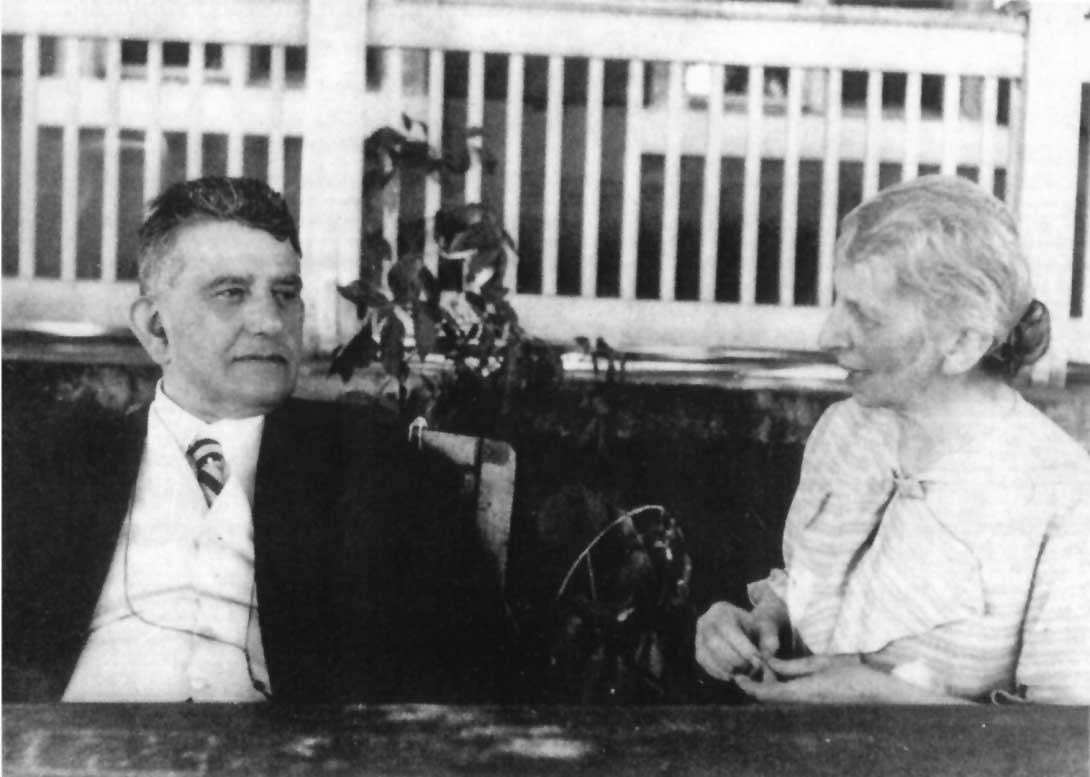 |
|---|
[Sources: Regina Pfennig (image at left), Harry Nutt, Bruno Cassirer, Stapp Verlag, Berlin, 1989 (remaining two images).]
The alliance between Bruno and Paul was to prove unstable. In 1901, they divided into a publishing house and art dealer's business and agreed not to compete directly for a period of seven years.
In 1902 Bruno began publishing the journal Kust und Kunstler (see below), which soon became influential. In the field of art and art history he published Welhelm von Bode, Alfred LIchtwark, Hugo v. Tschudi, Karl Scheffler, and many others [see Stanford University Cassirer Collection] He also published in the fields of philosophy and literature. There is a famous obscenity case against Bruno Cassirer and Frank Wedekind regarding Wedekind's Pandora's Box. After 1908 when the agreement not to compete with Paul ended, Bruno's publishing house began to produce what are said to have been the first illustrated art books. Slevogt and Walser were amongst his top illustrators. The last of the books published under its banner is dated 1936.
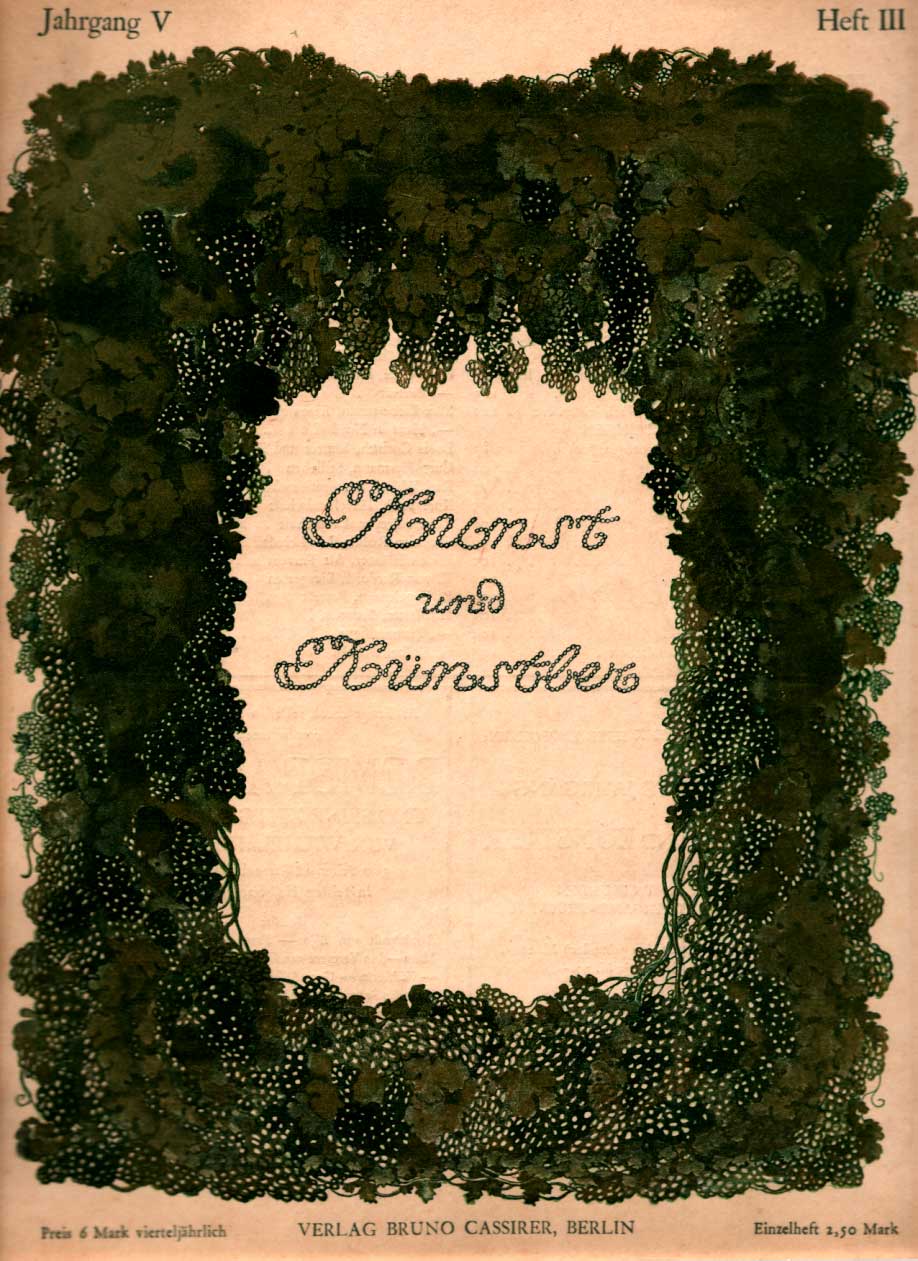 |
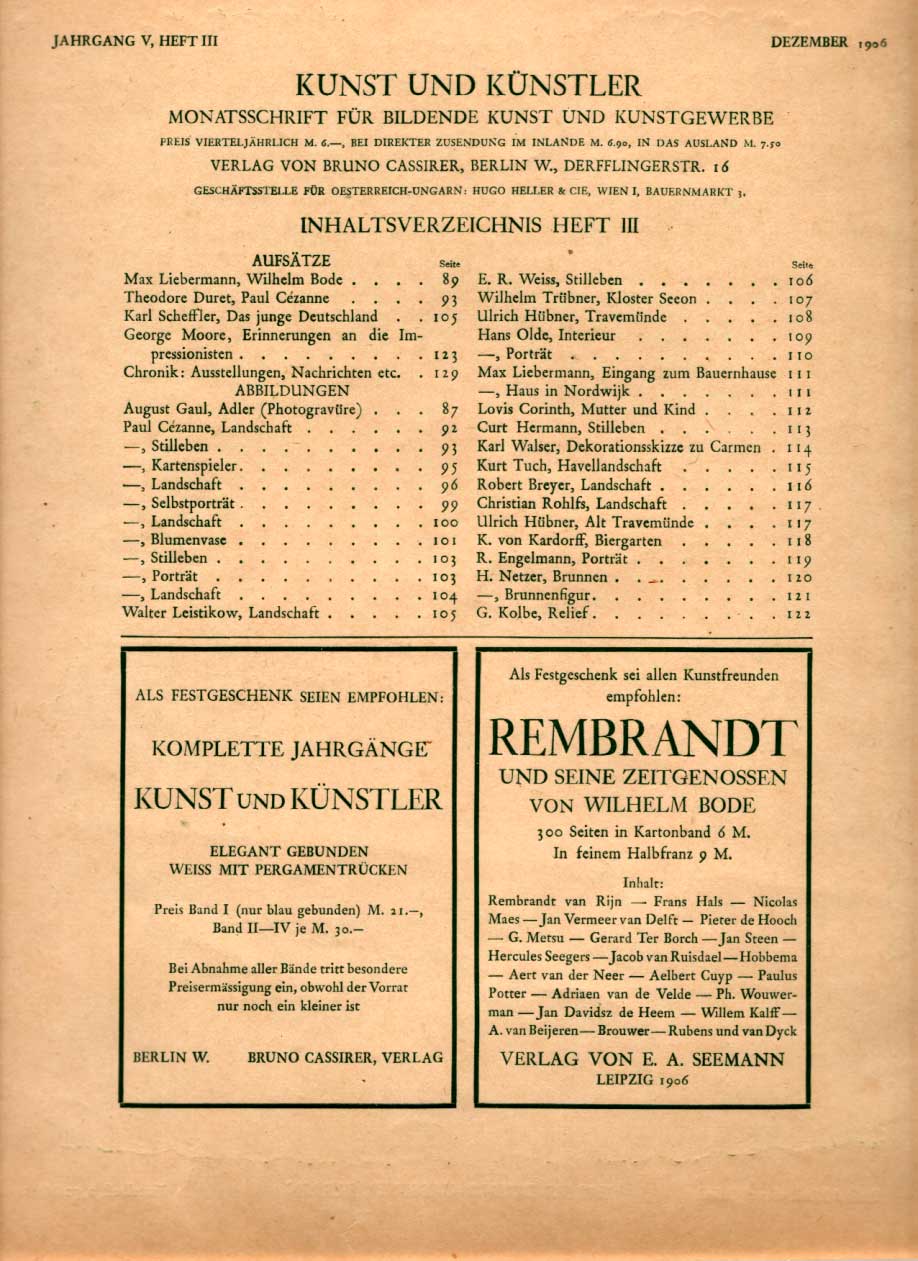 |
Kunst und Kunstler cover Dec 1906 |
Kunst und Kunstler contents page |
Click on images above to enlarge |
[Gift, generously donated, by Regina Pfennig, Templin, Germany] |
Shown below (first two panels, left to right) is a display stand, 1909 catalogue and 1930 display window for Bruno Cassirer Verlag (1930). Bruno Cassirer was also extremely interested in horses and horse racing. The Wilkipedia reports he bought his first trotting horse in 1899, began breeding trotting horses in 1905 and in 1919 assumed presidency of the Trotting Horse Association of Mariendorf. The right hand panel is a photograph of Bruno Cassirer's race horse, Colonel Bosworth in action.
|
|
|
|
In 1931 Bruno Cassirer acquired a horse establishment in what is now Templin in the district of Brandenburg. Later, he was forced by the Nazis to relinquish ownership of the complex. It is now the horse establishment and guest house Lindenhof (Lindenhof 1 17268 Templin). The complex, as it is now, is shown below.

Gestüt Lindenhof in 2004 - originally acquired by Bruno Cassirer in 1931
After his escape from Germany in 1938 Bruno Cassirer joined other members of the family in a move to Oxford England where he again established a publishing business as well as continuing his interest in horse racing. He died in 1941 and his son-in-law, Dr. George Hill (who changed his name from Günther Hell) continued the work of Bruno Cassirer (Publishers) Ltd.
Letter from Bruno Cassirer,
1925 [Click on image to enlarge; click here for translation
into English] |
Paul Cassirer (cousin of Bruno and son of Louis) went on with the art side of the business to become an outstanding art dealer. He led the discovery of the French impressionists in Germany and made a lot of money out of his successful promotion of them. He had a very artistic personality. Shown below are two photographs of Paul together with three sketches by the artist Emil Orlik.
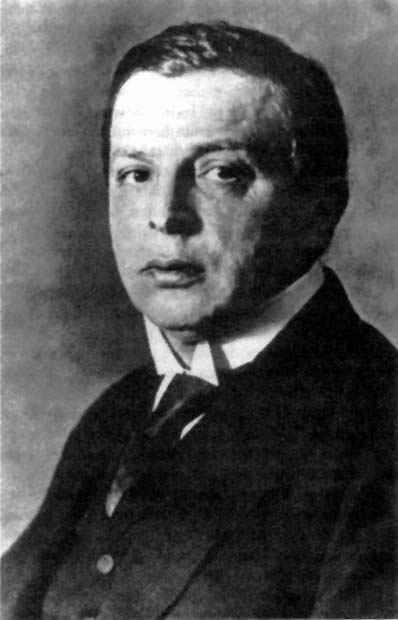 |
 |
 |
The year 1898 marked the formation of 'the Berlin Secession' - founded by artists as an alternative to the conservative exhibition and patronage policies of the art galleries, associations and state. The occasion was the rejection of a painting by Walter Leistikow, a leader of the modernist art trend. Similar secessions were being formed by artists throughout Central Europe. A number of Jewish collectors supported the Berlin Secession and Max Liebermann, who became its President, proposed that Paul and Bruno, with their gallery and publishing house, serve as its business managers. Bruno resigned in 1901, but Paul continued on playing a strong role. There were power struggles within the group and Paul was asked to take a six month leave in 1910, however he eventually was elected President from 1912-1915.
After Paul's split from Bruno in 1901, and the agreed wait of seven years in which he would not compete with Bruno, in 1908, he created his own gallery at 35 Victoriastrasse, Berlin (with an interior designed by Henri van de Velde) as an addition to his Paul Cassirer literature publishing house. An admission card for one of his exhibitions in 1902 is shown below.
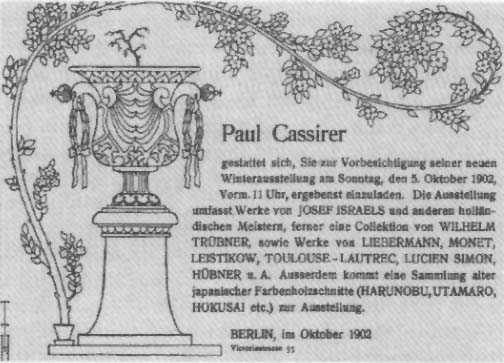
The gallery and publishing house were the vehicles through which Paul promoted impressionist and expressionist artists of the "citizens of the Berlin Secession" like Lovis Corinth (1858-1925) and Max Liebermann (1847-1935) as well as the early expressionist sculptor Ernst Barlach (1870-1938). Other artists whom he promoted included August Gaul and, Max Beckmann, Marc Chagall, Rudolf Grossman, Ludwig Meidner and Oskar Kokoschka. The reading room of his Kunstsalon and one of its gallery spaces, designed by the architect Henry van der Velde, is shown below. (The large central table that was made for it, shown below, remains in the possession of Professor Peter Paret).
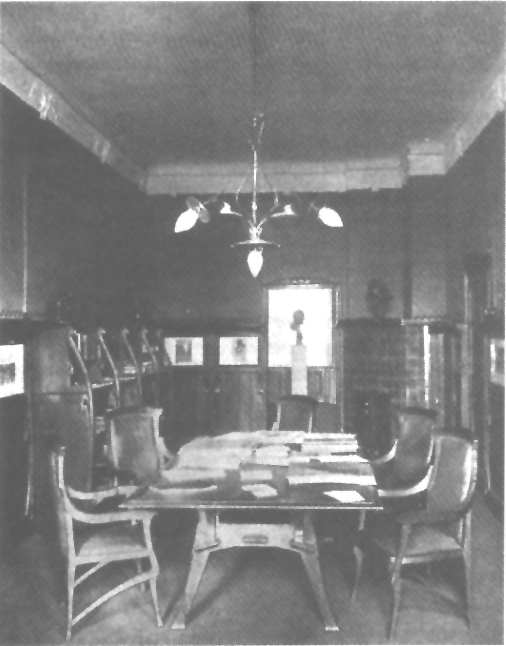 |
|
Paul Cassirer is acknowledged as playing a key role in promoting expressionism in Germany. But his reputation extends further. Writing on the issue of how the term "expressionism" came into existence, Lionel Richard, notes that whilst some attribute its origin in Germany to Willhelm Worringer, "Others, by contrast, grant this honour to Paul Cassirer, who, in 1910, is said to have announced, in front of a picture by Pechstein, in answer to a question as to whether this was still an example of impressionism, that it was an example of expressionism. As a result of this quip, the term is said to have come into vogue in artistic circles, before spreading into the news columns of the journals." [Lionel Richards, the Concise Encyclopedia of Expressionism, Omega Books, Hertfordshire, 1984, p.7.]
Paul Cassirer's art gallery became extremely well known as a, if not the, leading gallery in Berlin. He was the first to present major exhibitions of van Gogh and Cézanne. It was Grete Ring, who was then partner and managing director of Paul's Berlin firm, who (together with Walter Feilchenfeldt) realised that a number of works supposedly by van Gogh were fakes. They were able to connect the forgery to Otto Wacker, thus unleashing a scandal which began in January 1928 with the opening of the van Gogh exhibition at Cassirer's, and ended in December 1932 with Wacker being found guilty of fraud and the falsification of documents. [For more on this click here.]
In 1910 Paul created a division of his publishing house which produced luxury editions and, for a short time, a journal named "Pan" on literary and cultural matters and a theatrical company of the same name which sponsored theatre productions for invited audiences of drama forbidden by the censor for public performances. Amongst the more famous contributors to the Pan journal were Ernst Toller, Frank Wedenkind, Georg Heym, Franz Marc, George Lukacs and Ernst Bloch. In World War-I Paul's war experiences transformed him into an opponent of war . After 1918 he followed the USPD and published writings of socialist philosophers such as Karl Kautsky (1854-1938) and Eduard Bernstein (1850-1932) and above all anarchist writers.
The expertise developed by Paul in art, and in particular, in the French Impressionists, meant that the seven uncles were urged to purchase works that proved later to be extremely significant. For example, his uncle, Julius Cassirer, in 1900, bought the painting "Rue de Saint Honoré", by the French impressionist Camille Pissarro, from the artist's close friend and Paris dealer Durand-Ruel. The painting was subsequently inherited by his son Friedrich and his daughter-in-law Lilly. Pictures from the 1930s show the beautiful Pissarro painting in the living room of the Cassirers' residence in Munich. As will be described later, it was later seized by the Nazis and it remains to this day the center of a major controversy over whether it should be restored to the family.
The uncles and cousins also helped to support Paul's proteges. For example, the biography of sculptur August Gaul notes that in 1911, a Duck Fountain was endowed by Max Cassirer for placement in Hardenbergstrasse in Charlottenburg. This was the first of August Gaul's works to be erected in the Berlin city area. He also made a Cygnet Fountain for Max Cassirer (today at Kurfürstendamm on the corner of Leibnizstrasse in Berlin). Gaul was also commissioned to make grave monuments for Max and Alfred Cassirer which were erected in the cemetery in Heerstrasse, Berlin (although Max Cassirer's grave has been reutilised since Max died in London).
 |
|---|
Duck Fountain by
August Gaul, endowed to Berlin by Max Cassirer in 1911. [With
visitor, Sue
Rowley 1978] |
The important role of Paul (and Bruno) in supporting and popularising the work of these artists resulted in a number of portraits of members of the family by them. The exhibition of cultural products from Wilhelmine Berlin (1890-1918) at the Jewish Museum in New York in 2000 contained several such works, including an oil painting by Max Slevogt of Paul Cassirer's daughter, Suzanne Aimée Cassirer - said to be "one of the most memorable works in the exhibition", and a Max Liebermann painting of one of Paul Cassirer's daughters. This painting is shown below along with a very famous painting by Lovis Corinth of Bruno Cassirer's daughter Sophie Cassirer.
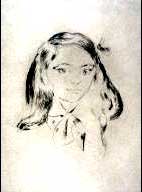 |
 |
| Suzanne Aimée Cassirer by Edvard Munch | Sophie Cassirer by Lovis Corinth |
Paul Cassirer was married in 1910 in a second marriage to a famous German actress Tilla Durieux (1880-1971) and lived in the zoo quarter in Tiergartenviertel, Vitoriastrasse 35. Tilla was famed both for her acting ability, and for her beauty. Perhaps also through the agency of Paul she was drawn and painted by several famous artists, including, most notably, Renoir.
|
Tilla Durieux |
Tilla Durieux by Renoir |
Tilla Durieux by Barlach 1912 |
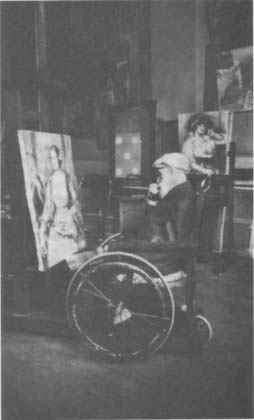
Renoir painting Tilla Durieux
In 1912 Tilla Durieux played the Circe in Calderon's comedy of the same name. In 1913 she played Frank Wedekind's Lulu in Munich. Durieux was the first to perform Oscar Wilde's Salome on the stage and also the first Eliza Doolittle in Shaw's "Pygmalion". In 1914 she made her film debut in the silent movie "Der Flug in die Sonne".

Paul with Tilla by Emil Orlik
In 1914 at the beginning of the First World War, Paul Cassirer began publishing a patriotic journal, Kriegszeit. (Some covers from 1915-16 are shown below).†
 |
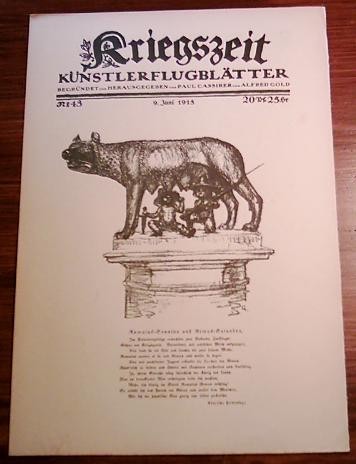 |
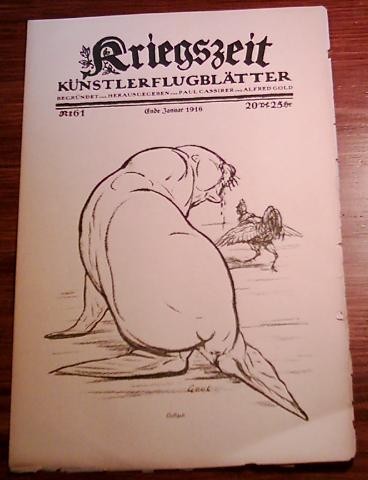 |
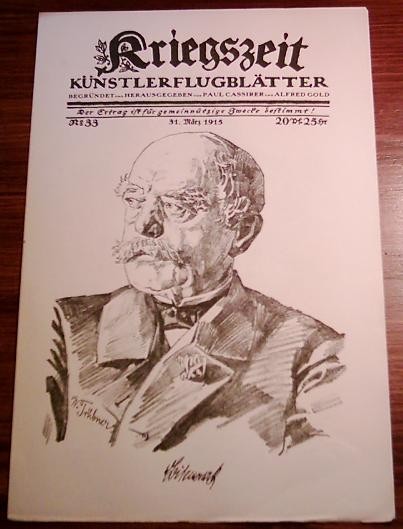 |
 |
 |
Paul volunteered for the Army in July 1914 but returned in 1916 as a pacifist. During the remaining years of the war he and Tilla became increasingly active politically. Paul was an independent Social Democrat (with the USPD) and in 1918 established the Bund neues Vaterland, a club which facilitated discussions between journalists and politicians.[see Stanford collection]
Despite Paul Cassirer's wealth and artistic eminence he was not appreciated by the Nazis. In 1920 in an early speech “Politik und Deutschtum” Hitler attacked Paul Cassirer as a millionaire who opposed National Socialism and tried to “confuse” the German people.
Paul's life was to end in tragedy. First, in 1919 his son Peter Cassirer, shortly after being demobilised from the army, shot himself. As Paul's grandson historian Peter Paret has noted "here a child's death cast a determining shadow over the father."
The final blow came some seven years later. After 16 years of marriage Tilla Durieux sought a divorce. On 7 January 1926 Cassirer met with his wife and the attorney, in order to sign the divorce documents. After signing he rose, bowed politely, apologized and went into the adjoining room. A shot rang out. Paul Cassirer lay in a blood pool. A few hours later he succumbed to the injury and died. He was buried in an army honour grave. A gallery named after him remains in Berlin.†
Death mask of Paul Cassirer, by George Kolbe |
Paul Cassirer's grave |
Erich Cassirer (a son of Isidor) was first a philosopher and then an art dealer. As a philosopher he wrote what has been referred to as "the comprehensive work of ERICH CASSIRER, Naturrecht und Völkerrecht im Lichte der Geschichte und der systematischen Philosophie (Berlin, 1919)" [Natural right and international law in the light of history and systematic philosophy].
Erich later established an art shop in Berlin and specialised in Egyptian and Oriental art. He was a very fine connoisseur. After he was forced to leave Germany he came to London and brought with him some of the art objects he had acquired.
Dr. Erich Cassirer at a wedding reception in 1930
In London Erich used these objects as the basis to establish a small gallery. Werner Falk, by then in Oxford, purchased some of these objects to help Erich become economically viable and some of these pieces remain in the possession of Werner Falk's family in Australia, the United Kingdom and America.
Cassirer: Schwientochlowitz to Breslau; Breslau to Berlin; Continuing the Entrepeneurship; Daughters; The Scattered Generations